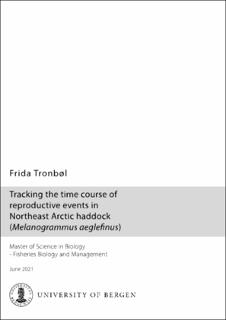Tracking the time course of reproductive events in the Northeast Arctic haddock (Melanogrammus aeglefinus)
Master thesis
Permanent lenke
https://hdl.handle.net/11250/2761235Utgivelsesdato
2021-06-15Metadata
Vis full innførselSamlinger
- Master theses [267]
Sammendrag
An important objective of fisheries management is to ensure harvest rates that allows the population to maintain its reproductive potential over time. Reproductive biology is thus of key importance when managing a fish stock as it largely determines the stock’s productivity and resilience to exploitation, yet limited information is available regarding the reproductive cycle of the presently studied Northeast Arctic (NEA) haddock (Melanogrammus aeglefinus) stock. Additionally, as stock assessment routines include year-specific maturity-at-age data from surveys to provide estimates of the spawning stock biomass, it is important that these maturity stage estimates are validated with more accurate methods. The purpose of the present study was first to track the time course of reproductive events in field-caught NEA haddock, and second, to evaluate maturity data and explore a rapid technique to separate stages that appear macroscopically similar. Results showed that the NEA haddock commit to maturity well before August, as seen from the presence of cortical alveoli oocytes (CAO) which prevailed as the most advanced oocyte phase for 4-5 months. Despite the early appearance of the CAO phase, the first entrance into vitellogenesis occurred in late October, marking the time of separation between females that develop ‘normally’ and mature females that will skip the spawning season. The majority (73.8 %) of skipping females reached the CAO phase and thereafter started atretic reabsorption of these oocytes. Neither liver energy storage (somatic hepatosomatic index) nor body condition (Fulton’s condition factor) could be directly linked to the occurrence of skipped spawning in the present study, although spatial and environmental factors potentially could have masked such effects. Notably, the occurrence of skipping was most common among second-time spawners (5-year-old females), apparently supporting a life-history driven mechanism for skipped spawning. The macroscopic maturity staging currently deployed during the annual Winter Survey at the Institute of Marine Research, was found to give correct estimates of the maturing portion of females but was not ideal for providing estimates of immature and skipping females. The subsequent attempt to use oocyte size frequency distributions to quickly separate immature and skipping females did not adequately provide a reliable tool for discrimination, due to the complexity of female maturity dynamics, confirmed by the ability to halt or revert the oocyte developmental process after the maturation and reproductive decision was made.
